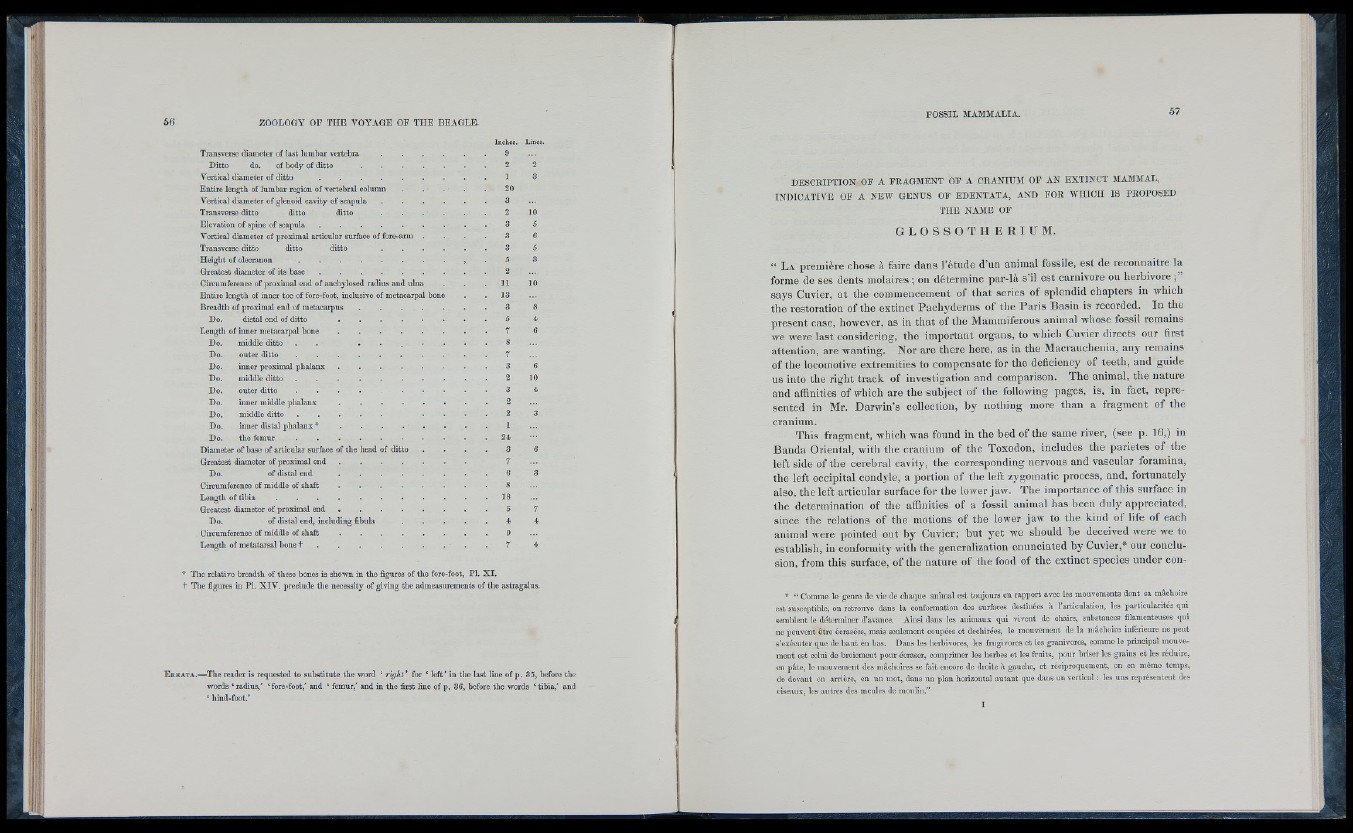
Transverse diameter of last lumbar vertebra . . . .
Ditto do. of body of ditto . . . . .
Vertical diameter of ditto . . . . . . .
Entire length of lumbar region of vertebral column
Vertical diameter of glenoid cavity of scapula . . . .
Transverse ditto ditto ditto . . . .
Elevation of spine of s c a p u l a ..............................................................
Vertical diameter of proximal articular surface of fore-arm .
Transverse ditto ditto ditto . . . .
Height of o l e c r a n o n ........................................................................
Greatest diameter of its b a s e ..............................................................
Circumference of proximal end of anchylosed radius and ulna
Entire length of inner toe of fore-foot, inclusive of metacarpal bone
Breadth of proximal end of m e t a c a r p u s ..........................................
Do. distal end of ditto ....................................................
Length of inner metacarpal bone . . . . . .
Do. middle ditto
Do. outer ditto
Do. inner proximal phala
Do. middle ditto
Do. outer ditto
Do. inner middle phalanx
Do. middle ditto
Do. inner distal phalanx*
Do. the femur
Diameter of base of articular surface of the head of ditto
Greatest diameter of proximal end . . . .
Do. of distal end . . . .
Circumference of middle of shaft . . . .
Length of tibia . . . . . . .
Greatest diameter of proximal end . . . .
Do. of distal end, including fibula
Circumference of middle of shaft . . . .
Length of metatarsal bone t . . . . .
Lines.
2
20
3
13
3
24
3
7
10
5
* The relative breadth of these bones is shown in the figures of the fore-foot, PI. X I.
t The figures in PI. X IV . preclude the necessity of giving the admeasurements of the astragalus.
E r r a t a .—The reader is requested to substitute the word ‘ r ig h t' for ‘ left ’ in the last line of p. 35, before the
words ‘ radius,’ ‘ fore-foot,’ and ‘ femur,’ and in the first line of p, 36, before the words ‘ tibia,' and
‘ hind-foot.’
DESCRIPTION OF A FRAGMENT OF A CRANIUM OF AN EXT INC T MAMMAL,
IN D IC A T IV E OF A N EW GENUS OF EDENTATA, AND FOR W H IC H IS PROPOSED
TH E NAME OF
G L O S S O T H E R I U M .
“ La première chose à faire dans l ’étude d’un animal fossile, e st de reconnaître la
forme de ses dents molaires ; on détermine par-là s ’il est carnivore ou herbivore
says Cuvier, at the commencement o f that series o f splendid chapters in which
the restoration o f the ex tinc t Pachyderms o f the Paris B asin is recorded. In the
present case, however, as in that o f the Mammiferous animal whose fossil remains
we were last considering, the important organs, to which Cuvier directs our first
attention, are wanting. Nor are there here, as in the Macrauchenia, any remains
o f the locomotive extremities to compensate for the deficiency o f teeth, and guide
us into the right track o f investigation and comparison. The animal, the nature
and affinities o f which are the subject o f the following pages, is, in fact, represented
in Mr. Darwin’s collection, b y nothing more than a fragment o f the
cranium.
This fragment, which was found in the bed of the same river, (see p. 16,) in
Banda Oriental, with the cranium o f the Toxodon, includes the parietes o f the
left side o f the cerebral cavity, the corresponding nervous and vascular foramina,
the left occipital condyle, a portion o f the le ft zygomatic process, and, fortunately
also, the le ft articular surface for the lower jaw. T h e importance o f this surface in
the determination of the affinities o f a fossil animal has been duly appreciated,
since the relations o f the motions o f the lower jaw to the kind o f life o f each
animal were pointed out by Cuvier; but y e t we should be deceived were we to
establish, in conformity with the generalization enunciated by Cuvier,* our conclusion,
from this surface, o f the nature o f the food of the ex tinc t spe cie s under con-
* “ Comme le genre de vie de chaque animal est toujours en rapport avec les mouvements dont sa mâchoire
est susceptible, on retrouve dans la conformation des surfaces destinées 'a l’articulation, les particularités qui
semblent le détoi-minor d’avance. Ainsi dans les animaux qui vivent de chairs, substances filamenteuses qui
ne peuvent être écrasées, mais seulement coupées et déchirées, le mouvement de la mâchoire inférieure ne peut
s’exécuter que de haut éii bas. Dans les herbivores, les frugivores et les granivores, comme le principal mouvement
est celui de broiement pour écraser, comprimer les herbes et les fruits, pour briser les grains et les réduire,
en pâte, le mouvement des mâchoires se fait encore de droite à gauche, et réciproquement, on en même temps,
de devant en arrière, en un mot, dans nn plan horizontal autant que dans un vertical : les uns représentent des
ciseaux, les autres des meules de moulin.”